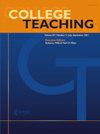Students’ Address and Reference Term Choices for Female versus Male Professors
Q3 Social Sciences
引用次数: 0
Abstract
AbstractUsing four methodologies, with both students and professors as participants, we predicted and found that college students are more likely to address/reference female versus male professors by first name. The effect was not explained by perceptions of lower status/competence or greater warmth, but rather more student-professor interaction. When we made first-name-only references impractical, students actually used more formal reference terms for female than male professors. We discuss potential moderating variables and implications for female faculty work life.Keywords: address termsgenderprofessorsreference termsrelationshipsstereotypestitles Ethics statementAll studies in this manuscript were approved by our university’s Institutional Review Board.Disclosure statementThe authors have no competing interests.Notes1 We examined the job status of those professors who were referenced at least once by name, identifying 69 (54 male, 15 female) as Full Professors, 30 (15 male, 15 female) as Associate Professors, and 62 (40 male, 22 female) as non-tenured faculty (Assistant Professors, Visiting/Adjunct Professors, and Lecturers). A gender × job status chi-square test resulted in a significant interaction, χ2(2, n = 161) = 8.10, p = .017, C2 = .05. + There were proportionally more male than female professors at the Full Professor level. To examine the potential role of job status differences in gender differences, we performed a gender × job status ANOVA on the first name references. + The gender main effect was still significant and had the same effect size, suggesting that job status accounted for none of gender’s effects on first name usage. + The only other significant finding was a job status main effect, F(1, 155) = 7.28, p = .001, η2 = .09. + Tukey post-hoc tests revealed that Associate Professors were more often referenced by first name, as compared to both Full Professors (p < .001) and non-tenured Professors (p = .006), which interestingly did not differ (p = .344).2 The website also included “easiness” ratings, which were similarly unrelated to professor gender and positively related to first name references.3 These results excluded 17 professors without quantifiable responses to the invitation item.4 We specified the audience as students taking the same class because we wanted students to feel free to use any reference term they wanted, as opposed to thinking they had to identify the professor by name to students who might be unfamiliar with the professor. If participants had to use the full name or last name for identification reasons, then it would introduce an element that is not relevant to situations in which address terms are used, thus making the comparison between reference and address terms more complex.5 We also ruled out some potential confounds (average class size, average grade earned in the class, average number of times students took that professor, average number of instructors taken by students, average number of terms students had been enrolled in college), none of which differed by professor gender.6 Study 1 was limited by potential selection bias if students with more extreme views of professors post more online reviews. Also, the website does not guard against fictitious responses or multiple responses from the same students. Studies 2 and 3 were limited their reliance on accurate and unbiased estimates. Study 4 involved fictitious scenarios which may not generalize.Additional informationFundingThis work was supported by a McNair Scholars Project Grant.学生对女、男教授称呼及参考用语的选择
摘要采用四种方法,以学生和教授为参与者,我们预测并发现大学生更倾向于直呼女教授的名字。这种影响不能用地位/能力较低或更温暖的感觉来解释,而是用学生与教授之间更多的互动来解释。当我们让只称呼名字的推荐人变得不切实际时,学生们实际上对女教授的推荐人比对男教授的推荐人更正式。我们讨论潜在的调节变量和影响女教师的工作生活。关键词:称谓、性别、教授、参考文献、关系、刻板印象、标题伦理声明本文所有研究均经我校机构审查委员会批准。声明作者与他人无利益冲突。注1:我们调查了那些至少被提及一次的教授的工作状态,确定69位(54位男性,15位女性)为正教授,30位(15位男性,15位女性)为副教授,62位(40位男性,22位女性)为非终身教授(助理教授,客座/兼职教授和讲师)。性别×工作状态卡方检验结果显示交互作用显著,χ2(2, n = 161) = 8.10, p = 0.017, C2 = 0.05。+正教授级别的男教授比例高于女教授。为了检验工作地位差异在性别差异中的潜在作用,我们对名字引用进行了性别×工作地位的方差分析。性别的主要影响仍然是显著的,并且具有相同的效应大小,这表明工作状态对名字的使用没有任何性别的影响。+唯一的其他显著发现是工作状态的主要影响,F(1,155) = 7.28, p = 0.001, η2 = 0.09。+ Tukey事后检验显示,与正教授(p < .001)和非终身教授(p = .006)相比,副教授更常被直呼其名,有趣的是,两者没有差异(p = .344)该网站还包括“轻松度”评分,同样与教授的性别无关,而与名字相关这些结果排除了17位对邀请项目没有可量化回应的教授我们将受众指定为上同一门课的学生,因为我们希望学生可以自由地使用他们想要的任何参考术语,而不是认为他们必须向可能不熟悉教授的学生说出教授的名字。如果参与者出于识别原因不得不使用全名或姓氏,那么它将引入一个与使用称呼术语的情况无关的元素,从而使参考术语和称呼术语之间的比较更加复杂我们还排除了一些潜在的混淆因素(平均班级规模、班级平均成绩、学生上该教授课的平均次数、学生上该教授课的平均次数、学生上该教授课的平均学期数),这些因素都没有因教授的性别而有所不同如果对教授持更极端观点的学生在网上发表更多评论,那么研究1就会受到潜在的选择偏差的限制。此外,该网站并没有防范虚构的回复或来自同一学生的多个回复。研究2和3对准确和无偏估计的依赖受到限制。研究4涉及虚构的场景,可能无法概括。本研究由麦克奈尔学者项目资助。
本文章由计算机程序翻译,如有差异,请以英文原文为准。
求助全文
约1分钟内获得全文
求助全文
来源期刊

College Teaching
Social Sciences-Education
CiteScore
1.50
自引率
0.00%
发文量
33
期刊介绍:
College Teaching provides an interdisciplinary academic forum on issues in teaching and learning at the undergraduate or graduate level. The journal publishes three kinds of articles. Regular, full-length articles of up to 5,000 words reporting scholarship on teaching methods, educational technologies, classroom management, assessment and evaluation, and other instructional practices that have significance beyond a single discipline. Full-length articles also describe innovative courses and curricula, faulty development programs, and contemporary developments. Quick Fix articles, up to 500 words, present techniques for addressing common classroom problems. Commentaries, up to 1,200 words, provide thoughtful reflections on teaching.
 求助内容:
求助内容: 应助结果提醒方式:
应助结果提醒方式:


